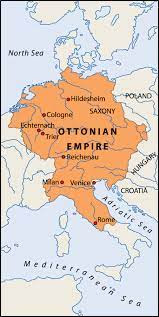Its founder was not named Otto, however (although his father was); that was Henry the Fowler (876 - 936), son of Otto the Illustrious. He was named primus inter pares (Latin: "first among equals") by the German dukes of Bavaria, Swabia, and Lotharingia during the Hungarian invasions of East Francia, and named Rex Francorum ("King of the Franks") in 919. He was victorious over the Hungarians and amassed sufficient power to be uncontested when he passed his title onto his son, Otto I (912 - 973).
Also known as Otto the Great, one of the chief historical events connected to him is the restoration of the Holy Roman Empire (which, it should be noted, was by any standard definitions neither "holy" nor "Roman" nor an "empire"). Sure, the administrative structure needed to manage the large area (shown in the illustration) was inherited from the Carolingians and Charlemagne, and they got it from the Romans, but it was nowhere near what the Roman Empire had been.
Pope John XXII, however, wanted Otto's help in controlling Rome and the Lombards. Otto was a good choice: he was geographically close to Rome, he had defeated the pagan Magyars in 955, making him look like a hero for Christianity, and he was (in some ways) the successor of a previous Frankish king, Charlemagne, who had been made Holy Roman Emperor in Christmas Day in 800. Otto, whose wife was the Italian Adelaide of Burgundy (931 - 999). stepped in for the pope and conquered the Kingdom of Italy in 961. He was crowned Holy Roman Emperor on 2 February 962.
The "re-creation" of the empire and its expansion to much of central and Southern Europe sparked a bit of a cultural resurgence, the Ottonian Renaissance. This continued under Otto the Great's son, Otto II, partially because of his marriage to Theophanu, the niece of Byzantine emperor John I Tzimiskes. This helped create an influx of Byzantine art into Europe.
Otto II died after only 10 years, aged 28. His son, Otto III, was only 3 years old; his regents were his mother Theophanu, his grandmother Adelaide, and Henry II ("the Quarrelsome"), Duke of Bavaria. When he came of age, among other things he installed his confidants as popes: Pope Gregory V and the science-minded Gerbert of Aurillac, Pope Sylvester II.
When Otto III died young (aged 21 years), he was succeeded by Henry II, a son of his regent Duke Henry. Henry was crowned emperor by Pope Benedict VIII in 1014. He founded numerous dioceses and intertwined secular and religious administrative power. When he died childless in 1024, the Ottonian dynasty ended. The crown went to Conrad II, a great-grandson of a daughter of Otto I, starting the Salian dynasty.
Before we can move to other topics, however, I want to look more at the results of the Ottonian Renaissance. See you tomorrow.








